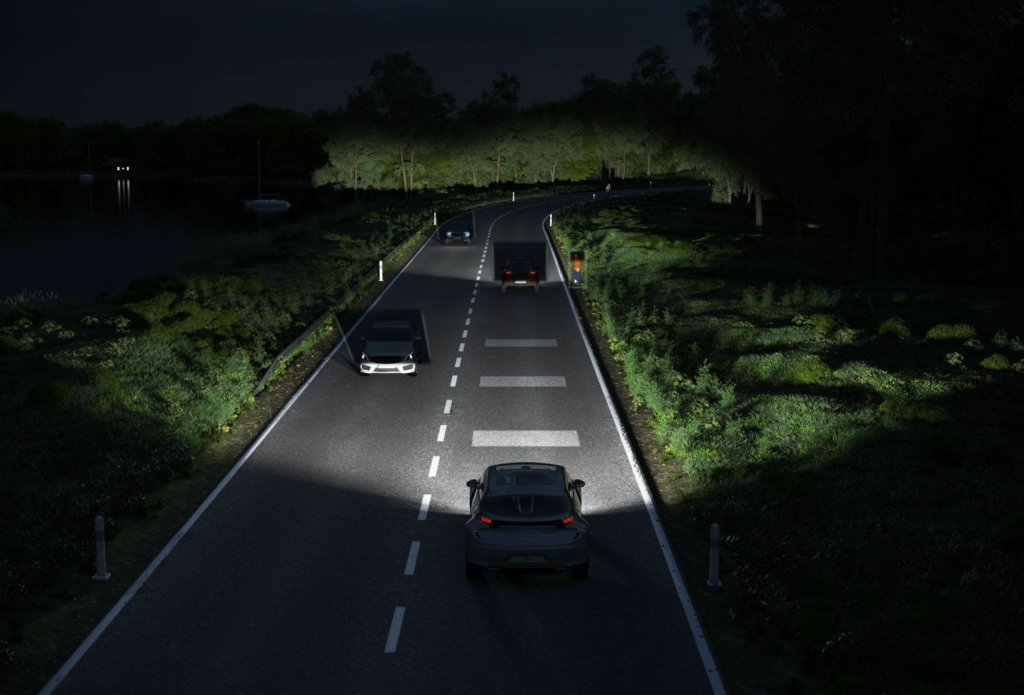
Driving at night presents a unique set of challenges, primarily due to reduced visibility and the risk of dazzling other road users. Automatic High Beams (AHB) are an innovative feature designed to address these challenges, enhancing nighttime visibility while minimizing the risk of causing glare to other drivers. This technology leverages advanced sensors and intelligent algorithms to automatically adjust the vehicle’s high beams based on road conditions and oncoming traffic. Here’s a closer look at how Automatic High Beams work, their benefits, and potential limitations.

1. How Automatic High Beams Work
Automatic High Beams use a combination of sensors, cameras, and software to manage the vehicle’s lighting system. Here’s an overview of their operation:
- Sensors and Cameras: AHB systems are equipped with forward-facing cameras and sensors typically mounted near the rearview mirror or on the windshield. These devices continuously monitor the road ahead and detect various lighting conditions, such as the presence of oncoming traffic or vehicles ahead.
- High Beam Activation: When driving at night, the system initially activates the high beams to provide maximum illumination. The sensors and cameras then assess the surrounding environment, including the presence of streetlights, other vehicles, and reflective road signs.
- Automatic Adjustment: If the system detects oncoming traffic or vehicles ahead within a certain range, it automatically dims the high beams to low beams to avoid blinding other drivers. Once the system determines that the road is clear of other vehicles, it switches back to high beams to maximize visibility.
- Adaptive Algorithms: The software within the AHB system uses adaptive algorithms to make real-time decisions about when to switch between high and low beams. These algorithms consider factors such as the speed of the vehicle, the distance to other road users, and the ambient lighting conditions.
2. Benefits of Automatic High Beams
Automatic High Beams offer several significant advantages that enhance driving safety and convenience:
- Improved Nighttime Visibility: One of the primary benefits of AHB systems is the enhanced visibility they provide. By automatically switching between high and low beams based on real-time conditions, the system ensures that the driver has the best possible view of the road without compromising the visibility of other drivers.
- Reduced Driver Fatigue: Night driving can be challenging and tiring, especially when manually adjusting the high beams. AHB systems reduce the need for manual intervention, allowing drivers to focus on the road and reducing overall fatigue.
- Increased Safety: By preventing glare for other road users, AHB systems help reduce the risk of accidents caused by temporary blindness or discomfort. This contributes to a safer driving environment for everyone on the road.
- Convenience and Ease of Use: AHB systems enhance driving convenience by automating the process of adjusting headlights. Drivers no longer need to manually toggle between high and low beams, making nighttime driving a more hassle-free experience.
3. Limitations of Automatic High Beams
While AHB systems offer valuable benefits, there are also limitations and considerations to keep in mind:

- Sensor Limitations: The effectiveness of AHB systems can be influenced by factors such as sensor placement, weather conditions, and road obstructions. For example, fog, heavy rain, or snow can impact the sensors’ ability to detect oncoming traffic accurately.
- Potential for False Alerts: AHB systems may occasionally produce false alerts or delay switching between high and low beams due to misinterpreting certain light sources or reflective surfaces. These false alerts can momentarily affect visibility and driver confidence.
- Driver Override: While AHB systems are designed to improve safety, drivers still have the ability to manually override the system if needed. In some situations, such as when driving in poorly lit areas or on rural roads, manual adjustment of the high beams may be necessary.
- Vehicle-Specific Features: The functionality of AHB systems can vary depending on the vehicle’s make and model. Some systems may have more advanced features or capabilities than others, so it’s important to understand the specific features of your vehicle’s AHB system.
4. Best Practices for Using Automatic High Beams
To maximize the benefits of Automatic High Beams and ensure their effective operation, consider the following best practices:
- Familiarize Yourself with the System: Review the owner’s manual to understand how your vehicle’s AHB system operates and what to expect. Knowing how to activate and override the system will help you use it effectively.
- Keep Sensors Clean: Ensure that the sensors and cameras used by the AHB system are clean and free from debris. Regularly check for dirt, snow, or other obstructions that could impact sensor performance.
- Understand System Limitations: Be aware of the limitations of your AHB system, such as its performance in adverse weather conditions or when encountering certain light sources. Use the system as a supplementary tool and exercise caution as needed.
- Maintain Manual Control: While AHB systems are designed to enhance safety, drivers should remain attentive and be prepared to manually adjust the headlights if necessary. This ensures that you maintain optimal visibility and avoid potential hazards.
5. Conclusion
Automatic High Beams represent a significant advancement in automotive lighting technology, offering enhanced nighttime visibility and improved safety. By automatically adjusting the high beams based on real-time road conditions, these systems help prevent glare for other drivers and reduce driver fatigue. Understanding how AHB systems work, their benefits, and their limitations allows drivers to make the most of this technology while maintaining safe and attentive driving practices. As automotive technology continues to evolve, Automatic High Beams remain a key component in creating safer and more comfortable driving experiences.







